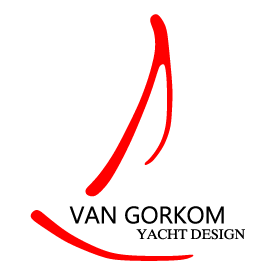Cost Effective Research & Development
One of the problems any yacht design company faces when it embarks upon a new design is being able to assess the vessel’s performance characteristics. If the design office does not have an extensive database of past proven designs to emulate, it is very important to the success of the project that a thorough research and development program be initiated.
There are many tools available to the designer to draw upon such as velocity prediction programs for sail boats (VPP), speed/power programs for power boats, computational fluid dynamic programs (CFD) for both power and sail, and the tank testing of scale models. These tools, used alone or in combination, can yield extremely valuable information and greatly contribute to the success of a design.
Of course these R&D efforts can be taken to the extremes where they will often cost more than, or almost as much, as the boat is actually worth. This level of effort only warrants the expense when the stakes are high, as seen with the Americas Cup, Whitbread Round the World projects, and Trans-Atlantic Power Boat record attempts. On a somewhat smaller scale, Van Gorkom Yacht Design faced this challenge with the design of their Mount Gay 30 and came up with a workable, cost effective solution which has yielded a wealth of knowledge and insight into the performance characteristics of their design.
This high-tech, low-budget approach served to not only validate this design and significantly reduce the overall cost of the boat, but give the client the confidence to fund the tooling and building of the first boat having been given a reasonable guarantee of the on-the-water performance. VGYD’s research and development program comprised of three phases: the model development by way of a complete parametric analysis, a one-model tank test series, and definitive post-analysis and optimization to formulate the final set of lines for the production female tooling.
Model Development
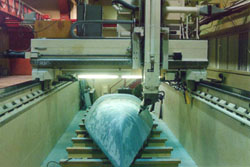
One of the underlying prerequisites for this design was to create a strong windward performer in wind speeds of between six to sixteen knots of true wind. This was deemed necessary to make the boat attractive to both East Coast and Great Lakes owners who typically race windward/leeward courses in light to moderate breezes. This is not to say that off-the-wind performance was compromised, as key features have been incorporated into the design to produce a strong all-round performer for both offshore and around-the-buoys events.
With an intuitive sense for what makes a yacht perform well, plus a complete parametric analysis based on a range of 30 footers with similar performance criteria to the Mount Gay 30, a set of parameters was defined in order to develop the lines for the tank test model, all while optimizing to the Mount Gay 30 Rule. This analysis included comparing physical parameters such as prismatic, water plane, block, and midship area coefficients, along with the displacement/length, sail area/displacement, sail area/wetted surface, beam/draft, and length/beam ratios. IMS rating certificates were also scrutinized for a series of the markets top 30 footers. This analysis readily illustrated the trends in performance based on the above physical ratios and velocity prediction outputs.
The choice of certain parameters was obvious, such as waterline length and displacement. Waterline length was maximized to reduce drag, and displacement was minimized to the Rule limits (2300 kgs). The most crucial choice was the beam. For off-the-wind sailing the narrower form is best for reducing wetted surface and wave drag, but for upwind, the hull must be wide enough to produce adequate stability to resist heeling force from the sails.
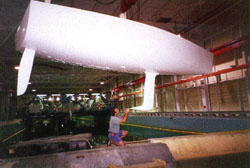
Considering that the boat can take on water ballast (and the further outboard you can get the weight the more righting moment, and consequently the more horsepower you will have) we decided to go with the maximum beam allowed by the Rule (3.35m). The hull form was given a fine bow entry for a strong windward performance and a gentle rocker and after sections conducive to off-the-wind sailing.
The lines were then created using Nautilus/Prosurf for Windows, an advanced lines fairing program featuring full NURB (Non-Uniform Rational B-spline) definition for curves and surfaces, facilitating the creation of a truly fair hull shape. This computer model was then given to Lite System for the milling of the model hull. Computer milling produced a very close-toleranced surface at a very affordable price.
The model was built to 2/3 scale, approximately 7.0 meters in length, and 1000kgs displacement. Building to such a large scale had several major benefits. Firstly, the dynamometer, which is the apparatus that connects the model to the towing carriage and measures loads resulting from heave, pitch, and yaw, required an optimum model weight of 1000kgs. This meant the best possible results could be achieved without using counter balances and risk inducing extraneous errors into the data collection. Also, the greater the scale of the model the cleaner the resistance data produced.
Tank Testing
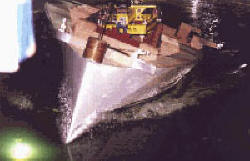
Since only one model was being tested with no keel and rudder variations, it was imperative that the resistance curves generated be as realistic and as accurate as possible so they could be used as an effective tool for the calibration of the VPP and ultimately in defining the final hull form.
The tank test experiments on the VG-Mount Gay 30 model were conducted at the National Research Councils Institute for Marine Dynamics in St. John’s, Newfoundland. Fluid Thinking Pty Ltd and the Australia One team used this facility in preparation for their 1995 Americas Cup challenge. IMD is regarded as one of the pre-eminent marine research facilities in the world. It boasts a 220 meter towing tank, a sophisticated towing carriage, and a hydraulically driven wavemaker capable of generating a wave height of up to one meter. The dynamometer was designed and built by Institute personnel specifically for Americas Cup Research.
Approximately 150 runs were made in the tank at various speeds, heel angles, yaw angles and rudder angles. A record of each run, describing the magnitude of the hydrodynamic forces that the canoe body and foils generated was recorded by the computer onboard the towing carriage. This information was then used to create a matrix of data which modeled the hydrodynamic characteristics of the hull form. The preliminary VPP modeling that was conducted during this testing proved to be extremely encouraging.
Post-Analysis & Optimization
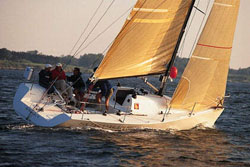
The data collected from these experiments has allowed VGYD to calibrate their VPP, and to simulate, in the computer, the same performance characteristics that the tank test model exhibited at IMD. A series of canoe body variations was then created and compared against the tested base boat. The goal was to create a computer model that made it possible to quantify those variations in terms of performance by racing the hull variations against the base boat in the velocity prediction program. This allowed us to fine tune the hull form resulting in what we considered to be the best performing hull form.
The velocity prediction program used in the post-analysis and the performance optimization was Winn Design VPP developed by Clay Oliver of Yacht Research International, Inc. YRI’s software was used exclusively by Team New Zealand in the last two Americas Cup. YRI performed the regression analysis on the final set of tank data to create a M30 module, proprietary to VGYD, used in their VPP.
Six systematic series were created, each with three to six boats. Each series explored different parameters such as: the beam/draft ratio, prismatic coefficient, slight changes in the after body, flare variations, and combinations of each. A fleet, consisting of the best performing hull forms from each series, was then raced in the VPP over a one mile windward/leeward course to come up with the fastest boat. Making this final analysis, allowed VGYD to enhance and optimize the performance of their VG-Mount Gay 30.
Cost Analysis
The total cost for the R&D of the VG-Mount Gay 30 was approximately one third of the total cost to put a boat on the water. That’s not bad considering what the client got for their investment: the building of the model, the tank testing, regression analysis of the tank test data, VPP software, and miscellaneous costs such as travel and communications. These factors had a direct bearing on the overall economics of the project by allowing the client to bypass the building of a prototype hull.
To summarize, it is possible to mount a thorough research and development effort for a fraction of the expense that is usually associated with this degree of effort. This is accomplished by utilizing some of the design tools and building processes that are now commercially available and are quite cost effective such as VPP and lines fairing software and computer milling. Development time is significantly reduced which also enhances the economics of the program.
The knowledge gained from this analysis has allowed VGYD to fine tune their design and given them a high degree of confidence in predicting the performance of their VG-Mount Gay 30 before it was even built. In fact, the correlation between VPP produced target boat speeds and actual on-the-water performance was very close. The design office is now working on several extrapolations of their M30 and feel extremely confident in their ability to gauge the performance of the boats based on their VPP development.
